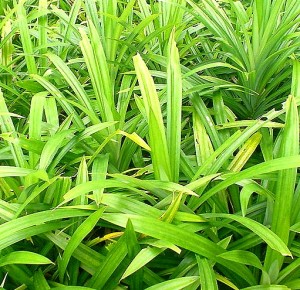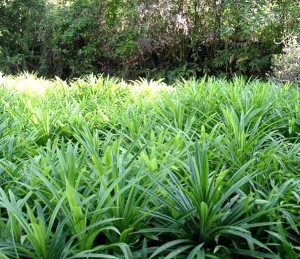 Pandanus amaryllifolius is a tropical plant in the screwpine genus which is known commonly as pandan. It grows up to 3-6 feet. Older plants develop thick aerial roots from the main stem. The leaves are slender about 12-14 inches long, smooth, pleated, sword-like and free from thorns. The leaves grow in a spiral around the main trunk; hence the name screw pine. The aromatic compound is located in little extensions of leaf cells called papillae on the under surfaces of the leaves. The plant is sterile, flowers only very rarely, and is propagated by cuttings.
Pandanus amaryllifolius is a tropical plant in the screwpine genus which is known commonly as pandan. It grows up to 3-6 feet. Older plants develop thick aerial roots from the main stem. The leaves are slender about 12-14 inches long, smooth, pleated, sword-like and free from thorns. The leaves grow in a spiral around the main trunk; hence the name screw pine. The aromatic compound is located in little extensions of leaf cells called papillae on the under surfaces of the leaves. The plant is sterile, flowers only very rarely, and is propagated by cuttings.
Pandan is popular due to its varied uses. It is sold in neatly-cut bundles in the wet market and supermarket. The plant is rare in the wild but cultivated widely for use as a flavoring in cooking. The leaves are used fresh or wilted, and are commercially available in frozen form in Asian grocery stores in nations where the plant does not grow. They have a nutty, botanical fragrance which enhances the flavor of Indonesian, Singaporean, Filipino, Malaysian, Thai, Bangladeshi, Vietnamese and Burmese foods, especially rice dishes and cakes. The leaves are sometimes steeped in coconut milk, which is then added to the dish. They may be tied in a bunch and cooked with the food. They also may be woven into a basket which is used as a pot for cooking rice. Pandan chicken, or gai ob bai toey, is a Thai dish with chicken wrapped in pandan leaves and fried. The leaves are also used as a flavoring for desserts such as pandan cake and sweet beverages.
Pandan leaves are also woven into mats, hats and bags and baskets. Its prominent aerial or prop roots are made into thread, rope for fishing lines, and tying and plating material for chairs. If moderately harvested, the use of prop roots for handicrafts will not affect the plant’s growth.
It is also said to have flavonoids which are believed to have a variety of healthful properties including antiviral, anti-allergen, antiplatelet, anti-inflammatory and antioxidant.
Plant Propagation
As the plant grows, it forms little suckers at the base of the mother plant. These little plantlets can easily be separated and transplanted. Cuttings can be made from the main trunk where sometimes little plantlets appear. Make sure there are at least several aerial roots included when making cuttings. Propagation can also be achieved using the tissue culture method.

How To Grow It
In areas where there is frost, it is best to keep the plant as a potted garden plant and bring it indoors during the colder months. It prefers indirect sun, with moist, well-drained soil rich in compost; and high humidity. Place the plant in a container of water for a few days until bigger roots appear. Thereafter, remove most of the leaves and plant it in well-drained soil under a full sun to partial shade. Water regularly.
Pandan is an ideal plant for the backyard. It doesn’t need much care and is seldom attacked by insects or diseases. Cut some leaves for cooking and it will grow back fast. When left to grow wild, it can develop many branches, which make it look quite bushy. It is actually quite an ornamental plant that grows and multiplies faster when grown in the ground.
Sources: www.uplb.edu.ph/fprdi, wikipedia.org; Photos: commons.wikimedia.org, greenculturesg.com